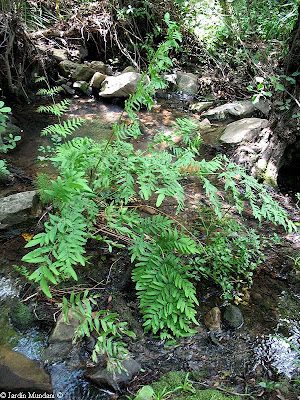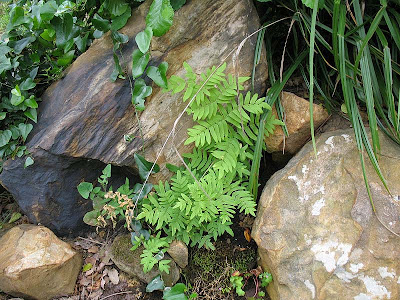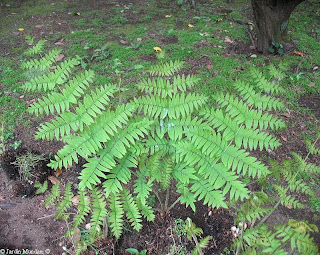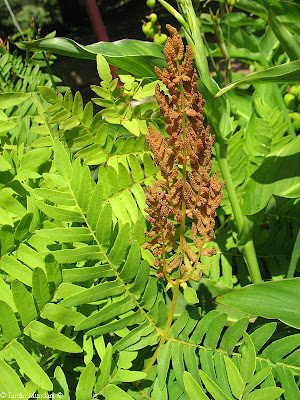Its primitiveness is perhaps the feature that best defines and because of its survival over millions of years. Not only has he been able to get to this day almost unchanged, but has been so successful that today is one of the most cosmopolitan ferns of the Earth, it dwells in every continent temperate, subtropical and tropical regions, except Australia and New Zealand. It is found throughout Europe, the Americas (North, Central and South America), in Asia, Africa, Madagascar and the Mascarene Islands, located in the southwest Indian Ocean.
Fronds of an old Osmunda regalis with nearly two feet long in the bed of the Arroyo del Parron in the Natural Park of Los Alcornocales in the province of Cadiz in mid-May. (Double click on the photo to enlarge)
The origin of its name is very confusing, there are many theories, but most accepted the result makes the generic name of King Osmund, who reigned in Lower Saxony to the year 758 ac. The species name "regalis" (roial) would thus have the same origin and translates as: "Fern of King Osmund." Produces heteromorphic fronds: sterile and fertile. Its spores are a unique feature among the ferns, are green chlorophyll content, which facilitates germination.
The family Osmundaceae is an isolated group unrelated to other ferns. They have found fossils of primitive osmundaceae Permian strata dated between 289 and 248 million years old. Fossils of modern Osmunda have been found in Cretaceous sediments dated at about 65 million years. The Osmundaceae family includes four genera: Leptopteris, Todea, Osmundastrum and Osmunda.
The family Osmundaceae is an isolated group unrelated to other ferns. They have found fossils of primitive osmundaceae Permian strata dated between 289 and 248 million years old. Fossils of modern Osmunda have been found in Cretaceous sediments dated at about 65 million years. The Osmundaceae family includes four genera: Leptopteris, Todea, Osmundastrum and Osmunda.
Beautiful sterile frond above Osmunda regalis. Is very striking green color, highlighting the aqueous background on which it is rooted. The sterile fronds of this fern in optimal conditions can reach eight feet. (Double click on the photo to enlarge)
New frond of Osmunda regalis the above, at first it upright stems and leaves as they grow leaning until its tip touches the water. Double clicking on the picture to enlarge you can see the very shaded aquatic habitat where they live. Just behind the frond is an outbreak of Equisetum telmateia.
Young cultivated Osmunda regalis in the Botanical Garden El Aljibe of the province of Cadiz, which preserves and reproduces this relatively rare botanical treasure in Andalucia.
Frond of fern above cultivated with the feet in the water as he likes. The fronds are lanceolate, bipinnate. The pinnules are oblong and asymmetrical.
Osmunda regalis sprouting in May after overwintering in the summit crater of a volcano in the center of the island of Faial in the Azores Archipelago, called Caldeira do Faial. To the left of the photo are several flowers of the ericaceae Daboecia azorica, Azorean endemic that grows like a carpet. On the frond are water droplets left by the passage of moisture-laden sea breeze, typical natural Macaronesian phenomenon called Horizontal Rain, which drains several times a day this wonderful archipelago lost in the Atlantic Ocean.
Osmunda regalis grown in the magnificent Botanical Garden of Faial in the island of the same name of the Azores Archipelago. In this garden is planted in full sun and does not seem to affect him negatively, perhaps because of the high humidity of these Atlantic islands.
Tender frond newly sprouted with the typical form coiled new growth of all ferns, which follow the Fibonacci mathematical principle. Is appreciated as a web fibrous sac that protects as it expands. The Osmunda regalis is deciduous, it loses its fronds in winter and resprout the following spring.
Osmunda regalis fertile frond that grows upright and has two types of pinnae, the lower are similar to those of the sterile fronds, while the upper or apical pinnae are formed by groups of sporangia filled with green spores. Sporangia of the photo are still immature. (Double click on the photo to enlarge)
Beautiful fertile fronds with mature sporangia, photographed in the Jardim Botânico do Faial in mid-May. If we give a small hit with a finger go out a cloud of spores that are dispersed by wind and water.
Another fertile frond of Osmunda regalis with mature sporangia. (Double click on the photo to enlarge)
Details of the sporangia frond above, which, unlike most ferns, not arranged in sori, but develop directly on the midrib of the pinnules.












No comments:
Post a Comment